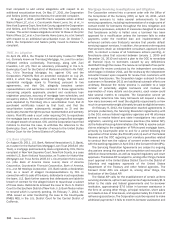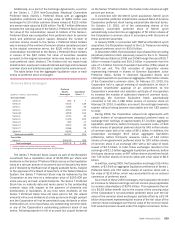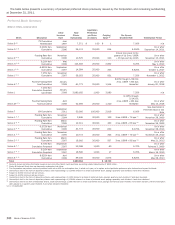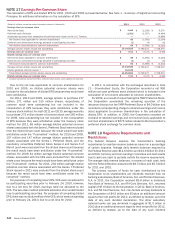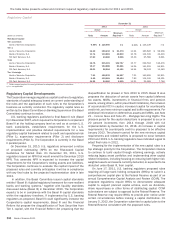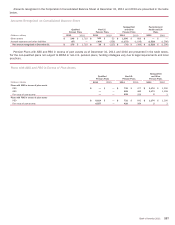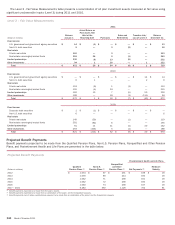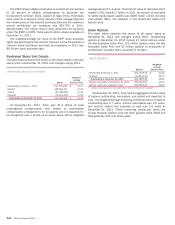Bank of America 2011 Annual Report Download - page 237
Download and view the complete annual report
Please find page 237 of the 2011 Bank of America annual report below. You can navigate through the pages in the report by either clicking on the pages listed below, or by using the keyword search tool below to find specific information within the annual report.Bank of America 2011 235
On July 19, 2011, the Basel Committee published the
consultative document “Globally systemic important banks:
Assessment methodology and the additional loss absorbency
requirement” which sets out measures for global, systemically
important financial institutions including the methodology for
measuring systemic importance, the additional capital required
(the SIFI buffer) and the arrangements by which they will be phased
in. As proposed, the SIFI buffer would be met with additional Tier
1 common equity ranging from one percent to 2.5 percent, and in
certain circumstances, 3.5 percent. This will be phased in from
2016 through 2018. U.S. banking regulators have not yet provided
similar rules for U.S. implementation of a SIFI buffer.
Given that the U.S. regulatory agencies have issued neither
proposed rulemaking nor supervisory guidance on Basel III,
significant uncertainty exists regarding the eventual impacts of
Basel III on U.S. financial institutions, including the Corporation.
These regulatory changes also require approval by the U.S.
regulatory agencies of analytical models used as part of the
Corporation’s capital measurement and assessment, especially
in the case of more complex models. If these more complex models
are not approved, it could require financial institutions to hold
additional capital, which in some cases could be significant.
On December 20, 2011, the Federal Reserve issued proposed
rules to implement enhanced supervisory and prudential
requirements and the early remediation requirements established
under the Financial Reform Act. The enhanced standards include
risk-based capital and leverage requirements, liquidity standards,
requirements for overall risk management, single-counterparty
credit limits, stress test requirements and a debt-to-equity limit
for certain companies determined to pose a threat to financial
stability. Comments on the proposed rules are due by March 31,
2012. The final rules are likely to influence the Corporation’s
regulatory capital and liquidity planning process, and may impose
additional operational and compliance costs on the Corporation.
NOTE 19 Employee Benefit Plans
Pension and Postretirement Plans
The Corporation sponsors noncontributory trusteed pension plans
that cover substantially all officers and employees, a number of
noncontributory nonqualified pension plans, and postretirement
health and life plans. The plans provide defined benefits based
on an employee’s compensation and years of service. The Bank
of America Pension Plan (the Pension Plan) provides participants
with compensation credits, generally based on years of service.
For account balances based on compensation credits prior to
January 1, 2008, the Pension Plan allows participants to select
from various earnings measures, which are based on the returns
of certain funds or common stock of the Corporation. The
participant-selected earnings measures determine the earnings
rate on the individual participant account balances in the Pension
Plan. Participants may elect to modify earnings measure
allocations on a periodic basis subject to the provisions of the
Pension Plan. For account balances based on compensation
credits subsequent to December 31, 2007, the account balance
earnings rate is based on a benchmark rate. For eligible employees
in the Pension Plan on or after January 1, 2008, the benefits
become vested upon completion of three years of service. It is the
policy of the Corporation to fund not less than the minimum funding
amount required by ERISA.
The Pension Plan has a balance guarantee feature for account
balances with participant-selected earnings, applied at the time a
benefit payment is made from the plan that effectively provides
principal protection for participant balances transferred and
certain compensation credits. The Corporation is responsible for
funding any shortfall on the guarantee feature.
As a result of acquisitions, the Corporation assumed the
obligations related to the pension plans of certain legacy
companies. These acquired pension plans have been merged into
a separate defined benefit pension plan which, together with the
Pension Plan, are referred to as the Qualified Pension Plans. The
benefit structures under these acquired plans have not changed
and remain intact in the merged plan. Certain benefit structures
are substantially similar to the Pension Plan discussed above;
however, certain of these structures do not allow participants to
select various earnings measures; rather the earnings rate is
based on a benchmark rate. In addition, these benefit structures
include participants with benefits determined under formulas
based on average or career compensation and years of service
rather than by reference to a pension account. Certain of the other
benefit structures provide a participant’s retirement benefits
based on the number of years of benefit service and a percentage
of the participant’s average annual compensation during the five
highest paid consecutive years of the last ten years of employment.
In connection with a redesign of the Corporation’s retirement
plans, after the end of 2011, the Corporation announced that it
will freeze the benefits earned in the Qualified Pension Plans
effective June 30, 2012. The Corporation will continue to offer
retirement benefits through its defined contribution plans and will
increase its contributions to certain of these plans.
As a result of the Merrill Lynch acquisition, the Corporation
assumed the obligations related to the plans of Merrill Lynch.
These plans include a terminated U.S. pension plan, non-U.S.
pension plans, nonqualified pension plans and postretirement
plans. The non-U.S. pension plans vary based on the country and
local practices. The terminated U.S. pension plan is referred to
as the Other Pension Plan.
In 1988, Merrill Lynch purchased a group annuity contract that
guarantees the payment of benefits vested under the terminated
U.S. pension plan. The Corporation, under a supplemental
agreement, may be responsible for, or benefit from actual
experience and investment performance of the annuity assets.
The Corporation made no contribution under this agreement in
2011 or 2010. Contributions may be required in the future under
this agreement.
The Corporation sponsors a number of noncontributory,
nonqualified pension plans (the Nonqualified Pension Plans). As
a result of acquisitions, the Corporation assumed the obligations
related to the noncontributory, nonqualified pension plans of
certain legacy companies including Merrill Lynch. These plans,
which are unfunded, provide defined pension benefits to certain
employees.



